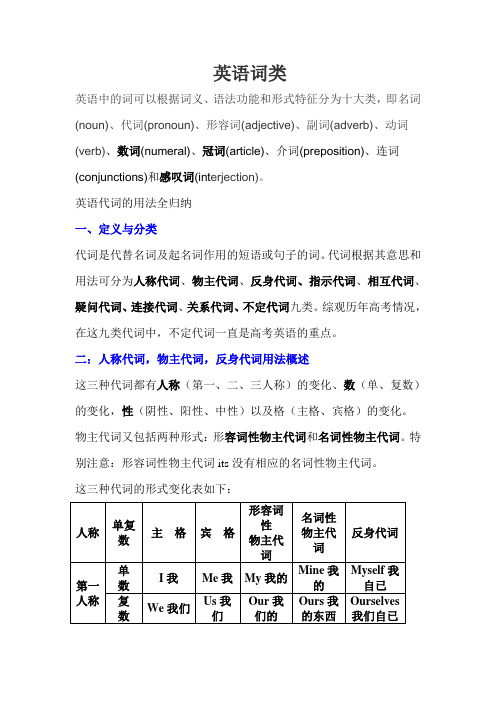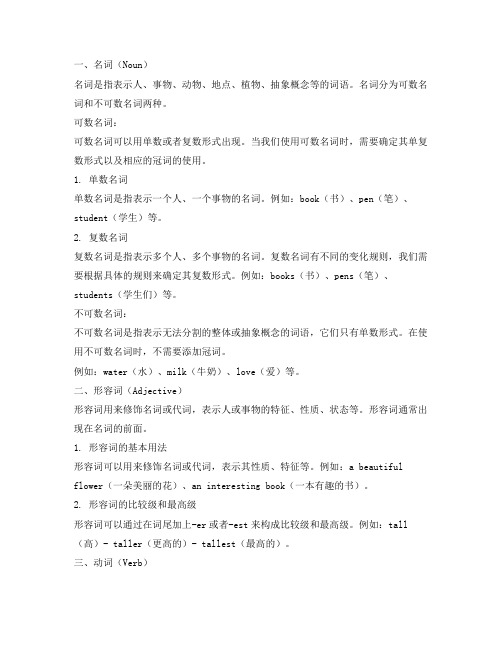(完整版)英语语法全解之代词
(完整版)英语代词的用法全归纳

英语词类英语中的词可以根据词义、语法功能和形式特征分为十大类,即名词(noun)、代词(pronoun)、形容词(adjective)、副词(adverb)、动词(verb)、数词(numeral)、冠词(article)、介词(preposition)、连词(conjunctions)和感叹词(int erjection)。
英语代词的用法全归纳一、定义与分类代词是代替名词及起名词作用的短语或句子的词。
代词根据其意思和用法可分为人称代词、物主代词、反身代词、指示代词、相互代词、疑问代词、连接代词、关系代词、不定代词九类。
综观历年高考情况,在这九类代词中,不定代词一直是高考英语的重点。
二:人称代词,物主代词,反身代词用法概述这三种代词都有人称(第一、二、三人称)的变化、数(单、复数)的变化,性(阴性、阳性、中性)以及格(主格、宾格)的变化。
物主代词又包括两种形式:形容词性物主代词和名词性物主代词。
特别注意:形容词性物主代词its没有相应的名词性物主代词。
这三种代词的形式变化表如下:三、人称代词的用法1) 定义:人称代词是用来指代人、动物或事物的代词。
它必须在人称(第一人称、第二人称、及第三人称)、数(单数、复数)以及性(阴性、阳性、中性)三方面与被指代的名词一致。
如:I am a student. Tom is a boy, and he is a student.Mary is very pretty, and she likes singing.The boys are students, and they are in the room.The doy is small. It is Tom's.2)人称代词的句法功能A) 人称代词有主格和宾语之分:主格用作主语,宾格用作宾语。
B) 人称代词的主格形式在在句中作主语和表语。
如: I like music(主语). She is a teacher.(主语)She and I are good friends(主语).Neither she nor I am student.——I saw the boys this morning.——Are you sure it was they(表语)?C) 人称代词的宾格在句子作动词的宾语,或者介词的宾语。
英语代词语法之人称代词

英语代词语法之人称代词英语代词语法之人称代词主格:I, we, you, he, she, it, they在句子中作主语宾格:me, us, you, him, her, it, them在句子中作宾语He and I are in the same class. 我和他在同一个班级。
Can you see them in the street? 你能看见他们在街上吗? 人称代词在句中的作用:1)主格作主语。
如:I am Chinese.我是中国人。
2)宾格作宾语,放在及物动词或介词之后,有时还可以在口语中用作表语。
如:①I don't know her.我不认识她。
(动词宾语)②What's wrong with it?它怎么了?(介词宾语)③-Open the door,please.3)作表语作表语一般用主格,但在口语中也常用宾格I saw at once it was her.我一下子看到了她。
It's me.请开门,是我。
(表语)4)作同位语作同位语是用宾格We ,us ,there,will be able to fulfill the task.我们三人就能完成这项任务。
主宾格的替换:一、宾格代替主格a.在简短对话中,当人称代词单独使用或在not后,多用宾语。
---- I like English. --我喜欢英语。
---- Me too. --我也喜欢。
---- Have more wine? --再来点酒喝吗?---- Not me. --我可不要了。
b.在表示比较的非正式的文体中,常用宾格代替主格。
但如果比较状语的谓语保留,则主语只能用主格。
He is taller than I/me.He is taller than I am.二、主格代替宾格a.在介词but,except后,有时可用主格代替宾格。
b.在电话用语中常用主格。
---- I wish to speak to Mary. --我想和玛丽通话。
高中英语语法总结大全之代词

高中英语语法总结大全之代词人称代词的用法1)人称代词的主格在句子中作主语或主语补语,例如:John waited a while but eventually he went home.约翰等了一会儿,最后他回家了。
John hoped the passenger would be Mary and indeed it was she.约翰希望那位乘客是玛丽,还真是她。
说明:在复合句中,如果主句和从句主语相同,代词主语要用在从句中,名词主语用在主句中,例如:When he arrived, John went straight to the bank.约翰一到就直接去银行了。
2)人称代词的宾格在句子中作宾语或介词宾语,但在口语中也能作主语补语,第一人称在省略句中,还可以作主语,例如:I saw her with them, at least, I thought it was her.我看到她和他们在一起,至少我认为是她。
(her做宾语,them做介词宾语,her作主语补语)a. -- Who broke the vase?--谁打碎了花瓶?b. -- Me.--我。
(me作主语补语= It's me.)说明:在上面两例句中,her和me分别作主语补语。
现代英语中多用宾格,在正式文体中这里应为she和I。
人称代词之主、宾格的替换1) 宾格代替主格a.在简短对话中,当人称代词单独使用或在not 后,多用宾语。
---- I like English.--我喜欢英语。
---- Me too.--我也喜欢。
---- Have more wine?--再来点酒喝吗?---- Not me.--我可不要了。
b.在表示比较的非正式的文体中,常用宾格代替主格。
但如果比较状语的谓语保留,则主语只能用主格。
He is taller than I/me.He is taller than I am.2) 主格代替宾格a. 在介词but,except 后,有时可用主格代替宾格。
超实用高考英语复习:高考语法填空抢分热点之代词(解析版)

高考语法填空抢分热点之代词一、考点精讲代词:1.人称代词分主格和宾格。
2.物主代词包括形容词性物主代词和名词性物主代词。
形容词物主代词修饰名词;名词性物主代词单独使用,相当于形容词物主代词加名词,后面不能再跟名词。
3.反身代词。
反身代词的固定搭配:devote oneself to“致力于,献身于”,其中to是介词;say to oneself“自言自语”;help oneself to“随便吃,自行取用”;by oneself“独自地,单独”;make oneself done“使某人自己被”;leave one by oneself“把某人自己单独留下”;enjoy oneself“过得愉快”;behave oneself“举止规矩”;come to oneself“苏醒过来”。
4.不定代词。
指人的不定代词:someone,anyone,somebody,anybody,everyone,everybody,nobody,no one;指物的不定代词:something;anything;everything;nothing;none既可指人也可指物,表示“一个也没有”或“一点也没有”。
5.it的用法(1)it作形式主语或形式宾语,代指动词不定式、动名词、名词性从句。
(2)用于强调句型:It is/was ...that/who...例如:It was he that/who broke the door.(是他弄坏的门);It was not until his father came back that he left home.(直到他的父亲回来,他才离开的家。
)温馨提示:这个句型不能强调谓语动词,强调谓语动词时应该用:助动词do/does/did+动词原形,意为“确实,务必,一定”。
例如:He did break the door.(他确实弄坏了门。
)(3)it的固定搭配:When it comes to...“当谈到......的时候”,其中to是介词;make it“成功做成某事”;as it is “事实上,照原样”;get it“明白了”;put it“叙述,说明”;see to it that,意为“注意,务必,一定要做到”。
高中英语语法之代词概述及各类代词用法讲义

高中英语语法之代词概述及各类代词用法归纳代词概述1. 什么是代词?代词是用来代替名词或名词短语的一类词, 它在句中的作用类似于名词。
代词可分为人称代词, 物主代词, 自身代词, 相互代词, 指示代词, 疑问代词, 连接代词, 关系代词和不定代词。
2. 代词在句中的作用1) 作主语That's my book. 那是我的书。
Both are expensive. 两个都很贵。
Who tells you this? 谁告诉你这个?2) 作宾语Take good care of yourself. 好好照顾自己。
I will show it to you. 我会展示给你看。
I don't believe him. 我不相信他。
3) 作表语The car is not mine. 这辆车不是我的。
I will be myself again soon. 我过一会儿就会没事了。
4) 作同位语The thing itself is not important. 事情本身并不重要。
They are both in favor of the plan.他们两人都赞成这个计划。
5) 作呼语You stand here and wait for the bus. 你站在这儿等公车吧。
Be patient, everyone. 大家都耐心点吧。
6) 作定语That's my glasses. 那是我的眼镜。
I'll buy that umbrella.人称代词1. 人称代词的词汇a) 人称代词主格 (在句中作主语)单数第一人称: I (我)单数第二人称: you (你)单数第三人称: he, she, it (他,她,它)复数第一人称: we(我们)复数第二人称: you(你们)复数第三人称: they (他们/她们/它们)b) 人称代词宾格 (在句中作宾语)单数第一人称: me (我)单数第二人称: you (你)单数第三人称: him, her, it(他,她,它)复数第一人称: us(我们)复数第二人称: you(你们)复数第三人称: them (他们/她们/它们)2. 人称代词在句中的作用1) 作主语I am a student. 我是一名学生。
外研版英语九年级下册Module2 名师总结:初中英语语法代词全解

名师总结:初中英语语法代词全解代词是代替名词、形容词和数词的词。
按其意义、特征及其在句中的作用分为:人称代词、物主代词、指示代词、反身代词、相互代词、疑问代词、不定代词和关系代词等。
一. 人称代词1.人称代词的人称、数和格,如下表所示。
2.人称代词有主格和宾格之分。
通常主格作主语,宾格作宾语。
如:I like table tennis. 我喜欢乒乓球。
〔作主语〕Do you know him? 你认识他吗?〔作宾语〕3.人称代词还可作表语。
作表语时用宾格。
如:---Who is knocking at the door? 是谁在敲门?---It’s me.是我。
4.人称代词在than之后与其他人或事物进展比拟时,用主格和宾格都可以。
如:He is older than me.他比我大。
He is older than I am. 他比我大。
二. 物主代词1.表示所有关系的代词叫物主代词。
物主代词分形容词性物主代词和名词性物主代词,如下表所示。
2. 形容词性物主代词的作用相当于形容词,可在句中作定语。
例如:Our teacher is coming to see us.我们的教师将来看我们。
This is her pencil-box.这是她的铅笔盒。
3. 名词性物主代词的作用相当于名词,在句中可用作主语、宾语和表语。
Our school is here, and theirs is there.我们的学校在这儿,他们的在那儿。
〔作主语〕--- Is this English-book yours? 这是你的英语书吗?〔作表语〕--- No. Mine is in my bag.不是,我的在书包里。
I've already finished my homework. Have you finished yours? 我已经做完家庭作业。
你做完了吗?〔作宾语〕三. 指示代词指示代词包括:this,that,these,those。
高中英语语法:代词之人称代词 (2)

《高中英语语法大全》第02章代词一、概说代词是代替名词及起名词作用的短语或句子的词。
代词可分为人称代词、物主代词、指示代词、相互代词、疑问代词、连接代词、关系代词、不定代词等九类。
二、人称代词1.人称代词的用法。
人称代词在句中可以用作主语(用主格,如I, you, he, she, we, they, 等)和宾语(用宾格,如me, you, him, her, us, them等):He loves her, but she hates him. 他爱她,但她却讨厌他。
注:(1)在口语中,当人称代词用作表语、用于than, as 之后或用于强调句中被强调时,可以用宾语:“Who is it?” “It’s me.” “是谁呀?”“是我。
”He sings better than me. 他比我唱得好。
He is as tall as her. 他和她一样高。
It’s me who did it.这是我干的。
但是,若than, as 后的人称代词后跟有动词,则必须用主格:He sings better than I do. / He is as tall as she is.(2)单独使用的人称代词通常用宾格:“I’m tired.” “Me too.” “我累了。
”“我也累了。
”“Who wants this?” “Me.” “谁要这个?”“我要。
”(3)有时用主格或宾格会导致意思的变化:I like you better than he. 我比他更喜欢你。
为I like you better than he likes you.之略。
I like you better than him. 我喜欢你胜过喜欢他。
为I like you better than he likes him.之略。
2.人称代词的排序:(1)人称代词的排列顺序为:单数人称代词通常按“二三一”排列,即you, he and I;复数人称代词通常按“一二三”排列,即 we, you and they:You, he and I are of the same age. 你,他和我都是同一年龄。
初中英语语法全解

一、名词(Noun)名词是指表示人、事物、动物、地点、植物、抽象概念等的词语。
名词分为可数名词和不可数名词两种。
可数名词:可数名词可以用单数或者复数形式出现。
当我们使用可数名词时,需要确定其单复数形式以及相应的冠词的使用。
1. 单数名词单数名词是指表示一个人、一个事物的名词。
例如:book(书)、pen(笔)、student(学生)等。
2. 复数名词复数名词是指表示多个人、多个事物的名词。
复数名词有不同的变化规则,我们需要根据具体的规则来确定其复数形式。
例如:books(书)、pens(笔)、students(学生们)等。
不可数名词:不可数名词是指表示无法分割的整体或抽象概念的词语,它们只有单数形式。
在使用不可数名词时,不需要添加冠词。
例如:water(水)、milk(牛奶)、love(爱)等。
二、形容词(Adjective)形容词用来修饰名词或代词,表示人或事物的特征、性质、状态等。
形容词通常出现在名词的前面。
1. 形容词的基本用法形容词可以用来修饰名词或代词,表示其性质、特征等。
例如:a beautiful flower(一朵美丽的花)、an interesting book(一本有趣的书)。
2. 形容词的比较级和最高级形容词可以通过在词尾加上-er或者-est来构成比较级和最高级。
例如:tall (高)- taller(更高的)- tallest(最高的)。
三、动词(Verb)动词表示动作、状态或存在。
动词通常用来说明主语在做什么,动词可以分为谓语动词和非谓语动词两种。
1. 谓语动词谓语动词是句子的谓语,用来说明主语的动作或状态。
谓语动词通常位于句子的谓语部分。
2. 非谓语动词非谓语动词是在句子中作其他成分的动词,它可以作主语、宾语、表语、定语、状语等。
非谓语动词通常有不定式、动名词和现在分词三种形式。
四、副词(Adverb)副词用来修饰动词、形容词或其他副词,表示时间、地点、原因、方式等。
- 1、下载文档前请自行甄别文档内容的完整性,平台不提供额外的编辑、内容补充、找答案等附加服务。
- 2、"仅部分预览"的文档,不可在线预览部分如存在完整性等问题,可反馈申请退款(可完整预览的文档不适用该条件!)。
- 3、如文档侵犯您的权益,请联系客服反馈,我们会尽快为您处理(人工客服工作时间:9:00-18:30)。
代词一、概说代词是代替名词及起名词作用的短语或句子的词。
代词根据其用法特点可分为九类:人称代词、物主代词、反身代词、指示代词、不定代词、相互代词、疑问代词、连接代词和关系代词等。
聚焦考点与汉语不同,在英语中代词使用非常广泛。
代词的数量有限,但种类和变化却非常繁多。
正确的使用代词可以使文章更加简洁、生动、富于变化。
代词是英语试题中考察较多的词类之一,考点在以下几个方面:形容词性物主代词和名词性物主代词的用法比较;人称代词的主格和宾格;不定代词的用法,特别是some,any,及其所构成的复合不定代词的考察,还有it的用法等。
二、人称代词1. 人称代词的形式2. 人称代词的用法人称代词在句中可以用作主语(用主格)和宾语(用宾格):He loves her, but she hates him. 他爱她,但她却讨厌他。
【说明】(1) 人称代词用作表语或用于than, as 之后时,可以用主格(较正式),也可用宾格(较口语化):“Who is it?” “It’s me.” “是谁呀?”“是我。
”He gets up earlier than me. 他起床比我早。
He speaks English as well as her. 他说英语说得跟她一样好。
但是,若than, as 后的人称代词后跟有动词,则必须用主格:He gets up earlier than I do.(此句不能用than me do)(2) 单独使用的人称代词通常用宾格:“I’d like a cup of tea.” “Me too.” “我想要杯茶。
”“我也是。
”(3)在电话中常用主格。
I wish to speak to Daming.我想和大明通话。
This is he.我就是3.常用人称代词的特殊用法。
(1)we they和you都可以指“人们”,因此不能翻译成“我们,你们,他们”They speak English in that country. 在那个国家,人们说英语。
(2)she可以用来指国家,船只,大地,月亮等。
China will always do what she has promised to do.中国总会按照自己的承诺去做事。
The moon was bright and big that night. She made us very happy.那晚的月亮又明又大,使我们非常高兴。
4. 人称代词的排列顺序人称代词的排列顺序为:单数人称代词通常按“二三一”排列,即you, he and I;复数人称代词通常按“一二三”排列,即we, you and they。
如:You, he and I are all middle school students. 你,他和我都是中学生。
We , you and they will all go there. 我们,你们和他们都将去那儿。
但若是用于承担责任或错误等场合,则可把第一人称I 置于其他人称代词之前:I and Tom are to blame. 我和汤姆该受批评。
三、物主代词1. 物主代词的形式2. 物主代词的用法形容词性物主代词在句中只用作定语;名词性物主代词则不能用作定语,但可以用作主语、宾语、表语、连用of作定语:My radio is cheaper than yours. 我的收音机比你的便宜。
定His sister is a friend of ours. 他的姐姐是我们的朋友。
定This is my seat. Yours is over there. 这是我的座位,你的在那儿。
主I have broken pencil. Please give me yours.宾This computer is this. Where is mine? 表The white skirt of hers is very beautiful. 与of连用作定语。
【说明】我们可以说 a friend of mine (ours, yours, hers, his, theirs),但是不能说 a f riend of me (us, you, her, him, theirs)。
3. 使用物主代词三个易错点(1) 误将物主代词与冠词、指示代词等连用。
如汉语可说“我的一个朋友”,但英语不能直译为my a friend,可说成a friend of mine;又如汉语可说“我的那个朋友”,但英语不能直译为my that friend,可说成that friend of mine。
(2) 受汉语影响混淆人称代词与物主代词。
如汉语说“我校”,说成英语应是my scho ol,而不能是I school;汉语说“他妈”,说成英语应是his mother,而不能是he mother。
(3) 受汉语影响漏掉必用的物主代词。
如汉语说“摇头”,说成英语应是shake one's h ead,而不是shake head;汉语说“照看父母”,说成英语可以是look after one's parents,但不能是look after parents。
(4)有时有无物主代词,意义相差很大。
如:别灰心,再试一次。
[误]Don’t lose your heart, and try again.[正] Don’t lose heart, and try again.[析]lose heart 意为“灰心”,lose one’s heart heart意为“钟情于,爱上”四、反身代词3. 反身代词的句法功能反身代词在句中主要用作宾语和同位语:He taught himself English. 他自学英语。
She is too young to look after herself. 她年纪太小,不能照顾自己。
He himself was a doctor. 他本人就是一位医生。
【说明】用作同位语主要是为了加强被修饰词的语气,通常紧放在被修饰名词后, 若不引起误解,也可放在句末:You yourself said so. / You said so yourself. 你自己是这样说的。
另外,反身代词有时还用作表语:The poor boy was myself. 那个可怜的孩子就是我自己。
I'm not quite myself these days. 我近来身体不大舒服。
几个固定结构:for oneself亲自of oneself自动in oneself本身固有by oneself独自You’ll have to see if she has comes for yourself.你得亲自去看看去他是否来了。
The computer can shut off of itself.计算机会自动关机。
五、指示代词1. 指示代词的形式与用法英语中的指示代词主要的有this(这个), that(那个), these(这些), those(那些),其中this 和that为单数,these和those为复数;this和these为近指,that和those为远指。
such(这样的人或事),same(同样的人或事)。
指示代词在句中可作主语、宾语、表语、定语:This is a very useful book. 这是一本很有用的书。
I don’t like that man. 我喜欢那个人。
I like these and he likes those. 我喜欢这些,他喜欢那些。
What I want to say is this. 我想说的就是这点。
【说明】指示代词用作主语和定语时,可指人或物;用作宾语和表语时,只指物。
如T his is my father. this 在句中作作主语,可以指人,但是在Do you know this? 中,this作宾语,此句只能理解为“你知道这个情况吗?”不能理解为“你认识这个人吗?”2. this 与that用法比较两者的基本区别是this表近指,that表远指。
另外,当要回指上文提到的事情时,可用this 或that,但是若要指下文叙述的事情,通常要用this:She married Jim, and this [that] surprised me. 她嫁给了吉姆,这使我感到很吃惊。
I want to know this—Does he love her? 我想知道这一点:他爱她吗?【说明】在打电话时,通常用this 指自己,用that 指对方:Hello. This is Mary. Is that Jim? 喂,我是玛丽,你是吉姆吗?不过,在美国英语中指对方时也可用this。
3. 表替代的that与those有时为避免重复,通常用that和those来代替前面已提到过的事物:The population of China are larger than that of Japan. 中国人口比印度人口多。
The ears of a rabbit are longer than those of a fox. 兔子的耳朵比狐狸的耳朵长。
上面第一句中的that代替the population,第二句的those代替the ears。
4.such和same的用法such所修饰的名词前如果有不定冠词,则不定冠词放在such之后。
I have never seen such an interesting film before.such做主语的时候,句中谓语动词的单复数形式由后面的名词形式决定。
Such is the way to work out the problem.Take such as you need.such做表语时,常和as和that 连用The people were such as I never saw before.这样的人,我从未见过。
same可以做主语,表语,宾语,定语,状语,无论哪种用法,前面都要theThe same is the case with me.我的情况也一样。
Those two girls are the same.那两个女孩是一样的,We must all say the same.我们必须说同样的话。
六、不定代词1. 不定代词概说不明确指代某个人或事物的代词叫不定代词。
不定代词是英语中最重要的一类代词,它不仅数量多、用法复杂,而且也是中考英语中的一类重要考点。
不定代词主要有:all 全体,全部each 每个both 两个都either 任意一个neither 两个都不one一个none 没有一个little 很少few 很少many 许多much 许多other 另外的another 另外一个some 一些any 一些,任何no 没有,无enough 足够的every 每个someone 某人somebody 某人something 某事anyone 任何人anybody 任何人anything 任何事everyone 每人everybody 每人everything 一切no one 没有人nobody 没有人nothing 没什么2. one的用法不定代词one指代可数名词,既可以指人,也可指物。
